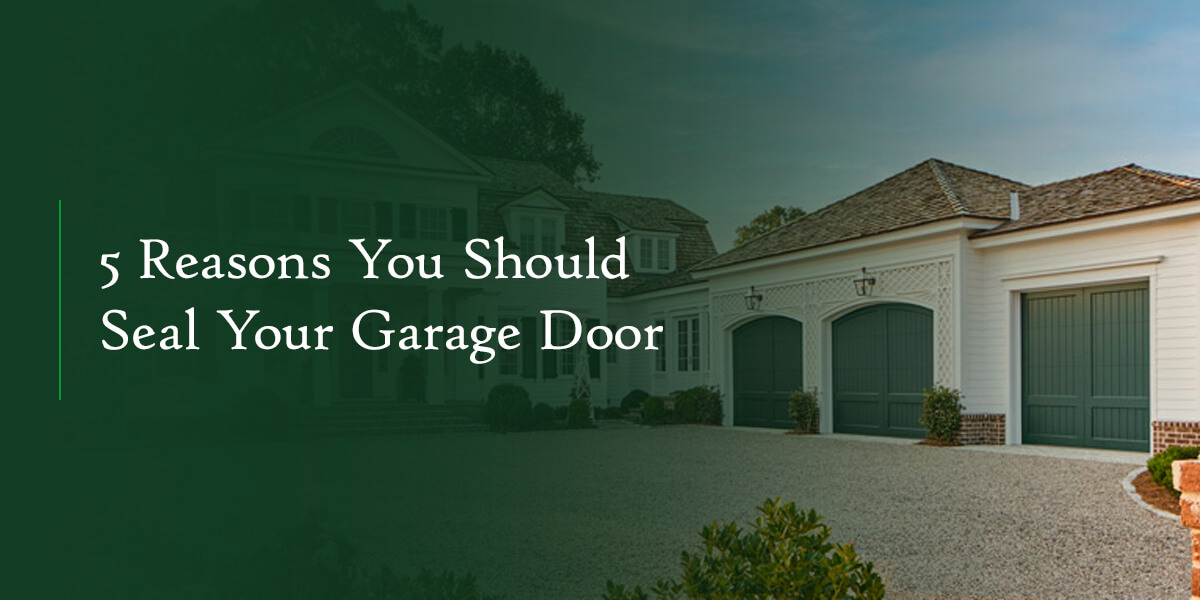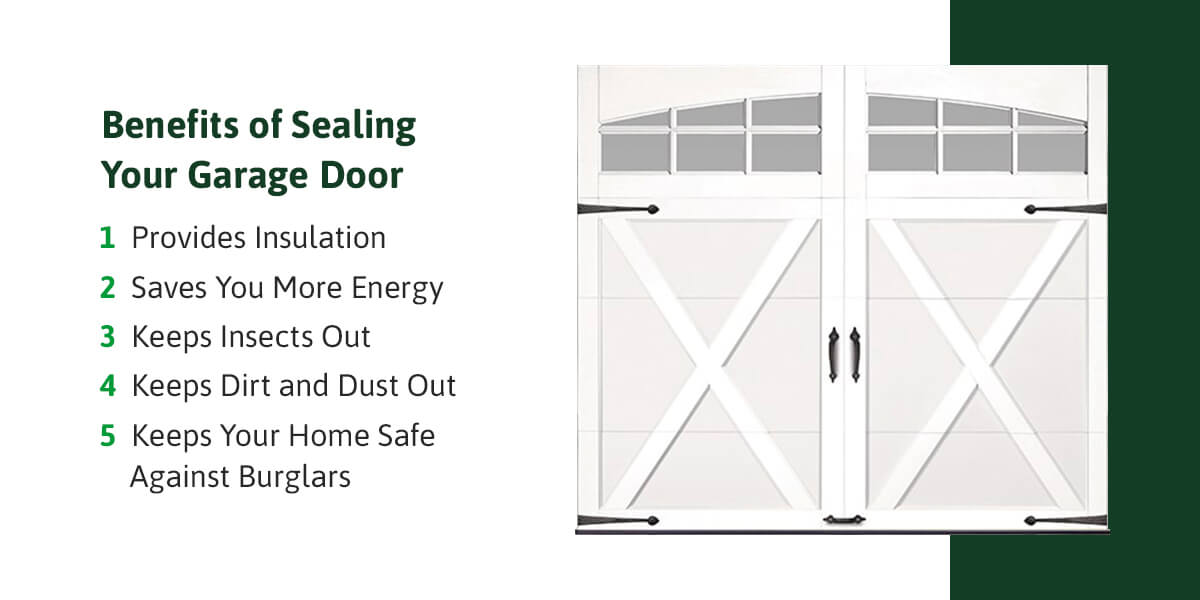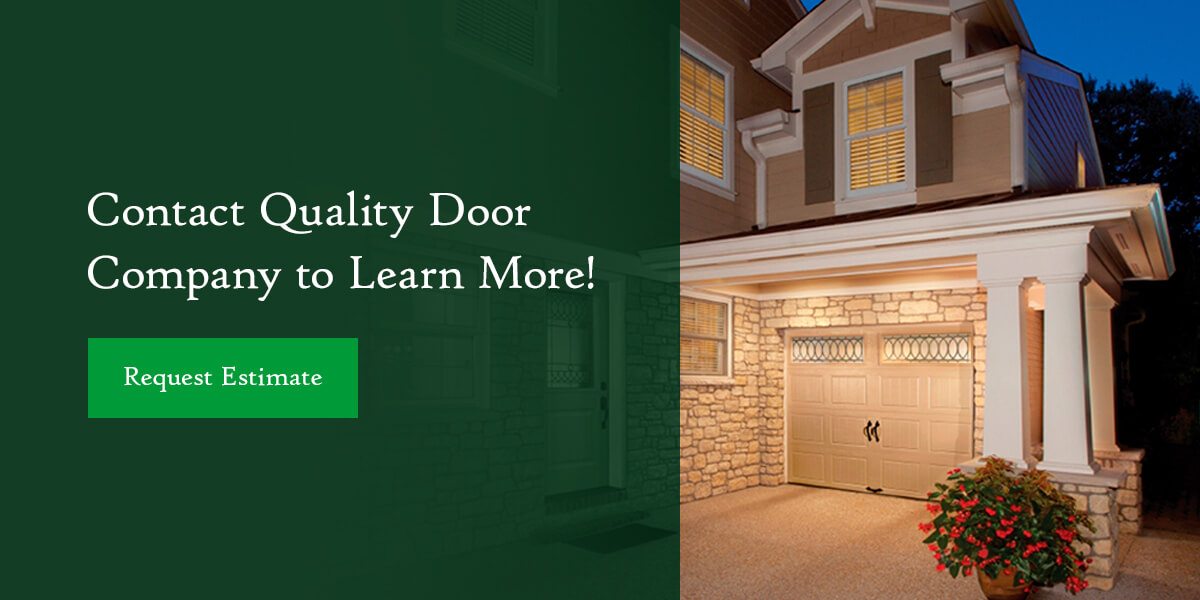Garages and garage doors are integral parts of residential properties. Garages are convenient places to secure your vehicles, protect your valuables or use as extra space for your gym equipment, office or storage facility. For this reason, taking good care of your garage door is vital. Sealing your garage door is one of the most critical steps.
This article addresses the most common concerns about sealing your garage door. We’ll discuss five benefits of sealing your garage door, look at types of weatherstripping and explore the signs you need to repair or replace your garage door seal.
Benefits of Sealing Your Garage Door
Garage doors are one of the largest doors in your home. They protect your vehicle and everything else on the inside, so it’s crucial to ensure that the entire space is covered to protect your home. Sealing your garage door keeps insects, dirt and dust out, saves you more energy, keeps your home safe against burglars and provides insulation. Let’s consider these benefits in more detail:
1. Provides Insulation
Sealing your garage door with weatherstrips helps you regulate your home’s temperature. If there are gaps around the door, it’s easy for air, water and ice to enter your property. Sealing your garage gives you more control and allows you to use the space for several purposes. Moreover, it protects your vehicle and other metallic items against weather elements such as oxygen and moisture that induce corrosion. Insulate your garage door to shrink your bills and protect your property.
2. Saves You More Energy
Energy saving is one of the many benefits garage door seals offer. Energy saving personally benefits you and the planet at large. Sealing garage doors help you control your home’s temperature so your garage is cooler during the hot seasons and warmer during the cold seasons. This benefit translates into low energy usage, meaning you can save money on electricity bills and reduce your carbon footprint. Insulating your home can help you save around 10% on your annual utility bills.
3. Keeps Insects Out of Your Garage
Sealing your garage door reduces the access route for insects and pests. Insects and pests have the skills to maneuver their way into our homes, usually uninvited, and can crawl through any gaps in your insulation to establish colonies in your home. There may even be instances where the areas around the garage door are wide enough to accommodate bigger animals, like mice and rats, which can both cause damage and spread disease. Good garage seals close up extra spaces around your garage door to keep insects and pests out.
4. Keeps Dirt and Dust Out of Your Garage
As the wind blows, it carries dust into our homes through unsealed spaces. This dirt can make its way into your garage if it’s not sealed, gathering on your vehicles and other tools or appliances you store in your garage. Sealing your garage door keeps your garage dust-free and clean. It saves you time and effort on cleaning and makes your garage a comfortable place to work or spend time.
5. Keeps Your Home Safe Against Burglars
Seal your garage door to protect your home and family from burglars. Garage doors are secured barriers meant to keep our homes and properties safe. Burglars take advantage of gaps around the garage door and open it with crowbars. If the gaps in your garage door are already wide, they might spy through the gaps to see if you store valuables in your garage.
Best Ways to Weatherseal Your Garage Door
There are several ways to seal your garage door. You can use bottom seals or door sweeps, threshold seals, door-stop weather stripping and panel weatherstripping to keep your garage secure.
- Bottom Seal: This garage door seal effectively keeps debris, pests, insects and air out of your garage. They’re fixed at the bottom of the garage door, providing a tight barrier for unwanted materials. There are different types of bottom seals, including the bulb, J-type, T-type and beaded seals.
- Threshold seal: Threshold seal weatherstripping is conducive to water protection and it’s fantastic for filling large gaps. They are usually made of vinyl, rubber or aluminum and are fixed on the garage floor rather than the door.
- Doorstop weatherstripping: These vinyl or rubber strips are used on the sides and top of the door. The garage door presses tightly against the strip, preventing rain and wind from entering. Doorstop weatherstripping is easy to install and can be done using nails or screws.
- Panel weatherstripping: Panel weatherstripping is used for garage doors with panels. They’re made of flexible rubber and designed in a V-shape, which creates a tight seal. They insulate your garage against air loss and debris.
How Often Should You Replace Your Garage Door Seal?
Your garage door seal could last months or years — an average long life span is between five to ten years. The life span of the seal varies depending on several factors, including the material used and the level of maintenance. As a rule of thumb, check the seal once or twice yearly.
How Do You Know When to Replace Your Garage Door Seal?
Pay attention to the following signs to know if you should replace your garage door seal:
- Light passes through the weak portions of the seal.
- Air enters the garage through the spaces on the sides.
- The seal begins to crack or break.
- Puddles of water gather around the garage door or inside your garage.
How Do You Maintain Your Garage Door Seal?
The best way to maintain your garage door seal is to ensure preventive maintenance. This requires you to maintain the strips regularly according to the planned schedule to prevent unexpected failures. To increase the life span of the seal:
- Clean it regularly with warm water, detergent and a soft bristle brush.
- Inspect the seals regularly to ensure there are no gaps or breaks.
- Apply spray foam for extra protection against pests.
Remember, replacing weatherstripping on your garage door is one the best ways to protect your garage — take advantage of it!
Contact Quality Door Company to Learn More about Sealing Garage Doors!
The benefits of weatherstripping garage doors are many. They offer extra protection, make your garage more energy efficient, provide additional insulation and protect your home against dust, water, snow, insects and burglars. It’s important to choose the kind of seal that is right for the part of the garage door you want to seal and check it once or twice a year to ensure it’s in good condition.
Quality Door Company is the leading dealer in residential garage doors in Western Michigan. We offer personalized maintenance services and carry high-quality models such as Clopay, Liftmaster and Cornell. Do you want to learn more about weatherstripping and insulating your garage door? Contact us today!




